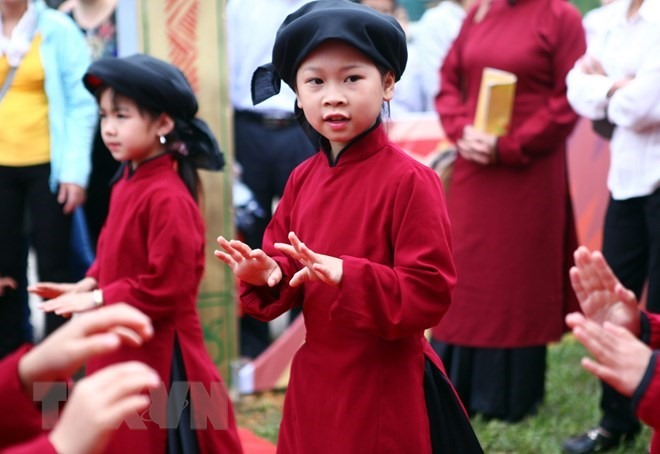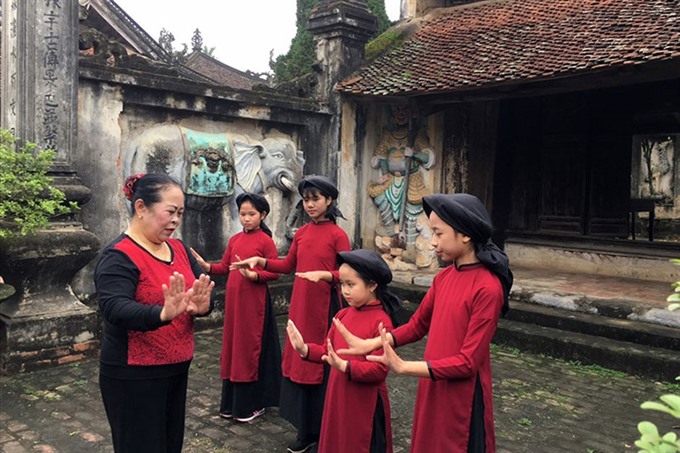 |
| Keeping it up: The young generation practices ancient Xoan singing in the northern province of Phu Tho . VNA/VNS Photo Trung Kien |
Viet Nam News
PHU THO — The ancient rules of Xoan singing state that only a man can hold the position of trum phuong xoan (head of xoan singing guild).
But after more than 50 years of enthusiastically and professionally performing xoan, not to mention training the next generation of singers, Nguyen Thi Lich, from Phuong Lau Commune, Viet Tri City in the northern province of Phu Tho has become the first female folk artist to lead the provincial xoan guild.
She is the first woman to hold such a position in the thousands-year history of xoan singing in Phu Tho— one of the unique traditional cultural music arts recognised by the United Nations Educational, Scientific and Cultural Organisation (UNESCO) as intangible cultural heritage.
Vu Ha Hung, an elderly member of the An Thai Xoan singing guild in Phu Tho Province, revealed that besides Lich’s high qualification in ancient xoan singing, her family history led the guild’s elders to choose her for the position.
Lich’s father was folk artist Nguyen Tat Thang, the head of a famous xoan singing guild in Phu Tho, regarded as the ancestral land of the Vietnamese.
Hung said all locals knew about her family’s story. Before passing away, Lich’s father gave her a notebook containing 31 ancient xoan songs. His last wish was that the daughter would protect and develop the family tradition.
At five years old, Lich needed support from her paternal grandfather, who taught her how to sing the songs.
At the age of 13, Lich was able to perform all the songs in the notebook left by her father, according to Hung.
Xoan performances then became an indispensable part of her life. In 1979, Lich became an adult and opened the first class teaching folk songs for children in her commune.
Her classes were all free and still run today. Lich has students from all parts of Phu Tho and other neighbouring provinces including Vinh Phuc and Yen Bai. Among her excellent students, folk artist Nguyen Thi Nga was also selected as the second female head of a xoan singing guild in Phu Tho.
 |
| Pathbreaking: Xoan singing artist Nguyen Thi Lich (left) is teaching the young about ancient Xoan performance. - Photo courtesy of Phu Tho Town |
In 2011, when the ancient xoan folk music was listed by the UNESCO as an intangible cultural heritage in need of urgent safeguarding, Lich was one of only seven folk artists who could perform all the ancient Xoan songs.
Phu Tho then launched a campaign themed “Protection and Development of Living Treasures” under which the seven folk artists were asked to maintain the activities of four xoan singing guilds under their charge and teach the folk genre to the next generations.
“We call them the source of masters of the heritage,” said Nguyen Dac Thuy, director of the Phu Tho Culture, Sports and Tourism Department.
Over the last four years, Lich has not missed a single xoan singing class held on Saturdays and Sundays. She has trained nearly 70 folk artists who now teach xoan singing like her.
Phu Tho now has a regulation on conferring the title of xoan singing artist to motivate and recognise their contributions to the community.
At once facing the risk of becoming lost in oblivion, with only seven to eight performers throughout the province, now the number of singers has risen to 68 with 34 clubs and about 1,500 members performing xoan, Thuy said.
UNESCO’s 12th session of the Intergovernmental Committee for the Safeguarding of the Intangible Cultural Heritage, held in South Korea early last December, announced an unprecedented decision to remove the xoan folk music from the UNESCO List of Intangible Cultural Heritage in Need of Urgent Safeguarding and place it on the List of Intangible Cultural Heritage of Humanity.
According to Lich, the teaching of xoan singing to the next generations was crucial to strengthening the art form enough that it could be taken of the urgent safeguarding list.
A report from provincial authorities said the promotion of the xoan heritage of the Hung Kings ancestral worship, which was recognised as one of the world’s intangible heritage in 2012, should be connected to the development of tourism through performances of Xoan singing troupes from 2016 to 2020.
The ancient xoan is a genre of Vietnamese folk music performed in the spring during the first two months of the Lunar New Year, or Tet, in Phu Tho Province.
Traditionally singers from xoan guilds performed songs in sacred spaces such as temples, shrines and communal houses for the spring festivals. There are three forms of xoan singing: worship singing for the Hung Kings and village guardian spirits; ritual singing for good crops, health and luck; and festival singing where villagers alternate male and female voices in a form of courtship.
Each xoan music guild is headed by a leader, referred to as the trum; male instrumentalists are called kep and female singers dao.
The singing is accompanied by dancing and musical instruments such as clappers and a variety of drums. The music has a spare structure with few ornamental notes and simple rhythms and xoan is characterised by a modulation between singers and instrumentalists at the perfect fourth interval.
Knowledge, customs and techniques for singing, dancing and playing drums and clappers are traditionally transmitted orally by the guild leader.
However, the majority of bearers are now over 60 years old and the number of people who appreciate xoan singing has decreased, necessitate the training of young people.
Legend has it that on the way home after defeating the aggressors, a Hung king met buffalo-tending children singing children’s folk songs. The king then taught them the songs and dances of the Lac Viet – the people of Van Lang, the kingdom ruled by the Hung Kings.
People later built Lai Len Temple in Kim Duc Commune in present-day Phu Tho Province as the original communal hall of xoan singing. Ancient documents showed that Lai Len Temple was the first theatre of the Vietnamese. VNS
OVietnam